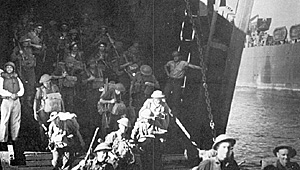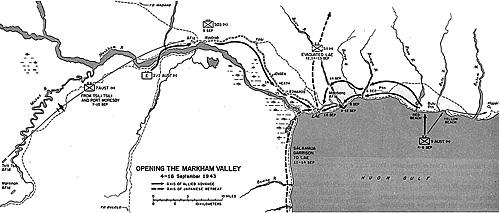The Landing
The unit slated to invade Lae, Maj. Gen. G. F. Wootten's s 9th Australian Division, embarked on the ships of Admiral Barbey's Task Force 76 at Milne Bay on 1 September.
(This section is based on Morison, Breaking the Bismarcks Barrier, Ch. XIV; Off of Chief Engr, GHQ AFPAC, Engineers in Theater Operations, p. 106, and Critique, p. 97; ALF, Rpt on New Guinea Opus: 4 Sep 43-26 Apr 44; Combined Operational Int Center GHQ SWPA, Resume . . . Lae and Salamaua, in GHQ SWPA G-3 Jnl, 20 Sep 43; 2d ESB Rpt.)
Next day Barbey's ships sailed to Buna and to Morobe, where they were joined by fifty-seven landing craft of the 2d Engineer Special Brigade that had assembled there in the latter part of August. On the night of 3-4 September the armada set out for Lae, eighty miles distant; it arrived at the landing beaches east of Lae at sunrise Of 4 September. (Map 13)
At 0618, eighteen minutes after the sun rose, five destroyers fired a ten-minute bombardment on the beaches. Then sixteen landing craft from the APD's started for the beaches carrying the assault waves.
At 0631 the 20th Australian Infantry Brigade began going ashore at Red Beach, near Bulu Plantation and some eighteen miles east of Lae. This landing was unopposed. Two minutes later troops of the 26th Australian Infantry Brigade landed at Yellow Beach, eighteen miles east of Lae, east of the Bulu River. A small group of Japanese on Yellow Beach ran away at the approach of the Australians. Scouts of the 2d Engineer Special Brigade landed with the Australian infantry.
Fifteen minutes after the assault waves beached, LCI's pushed their bows onto the beaches and put more riflemen ashore. They were followed by LCT's and LST's. All assault troops had landed by 083o, and by 1030 fifteen hundred tons of supplies had been landed. By the end of the day the beachheads were secure, 2,400 more Australians had landed, and the 26th Brigade and the 2/17th Australian Infantry Battalion had crossed the Buso and begun the advance westward against Lae.
There was no resistance on the ground, but Japanese aircraft attempted to break up the invasion. About 0700, before fighter cover had arrived, a few two-engine bombers with fighter escort attacked Task Force 76 and damaged two LCI's. Imamura dispatched eighty planes from Rabaul to attack Barbey but these were delayed by the fog over New Britain that Kenney's weathermen had predicted.
The picket destroyer Reid's radar located them over Gasmata in the afternoon just as Task Force 76 was making ready to sail for Milne Bay. The Reid vectored out forty P-38's and twenty P-47's which intercepted the flight and broke it up.
 AUSTRALIAN TROOPS DEBARKING from LST's for the occupation of Lae.
AUSTRALIAN TROOPS DEBARKING from LST's for the occupation of Lae.
Some planes got through, however, and attacked a group of six LST's off Cape Ward Hunt. They damaged two and killed over a hundred Australian soldiers and American sailors. The Japanese did not attack the jammed landing beaches at this time, but returned in the evening to blow up an ammunition dump, damage two beached LCI's, and kill two men. (They claimed to have sunk 14 transports, 2 barges, 1 PT boat, 3 destroyers, and to have shot down 38 planes.)
The Advance Westward
Once the assault troops had landed control of the 2d Engineer Special Brigade elements-thirteen hundred men of a reinforced boat company, a boat control section, a shore battalion, a medical detachment, scouts, and a headquarters detachment--passed from Admiral Barbey to General Wootten. A salvage boat, ten LCVP's, and two additional LCVP's mounting machine guns for support of landings remained at Red Beach. Eventually, twenty-one LCM's and twentyone LCVP's were sent to Red Beach. Because of breakdowns, these replacements were necessary if ten craft of each type were to be kept in operation. All these craft were used to support the 9th Division's march against Lae.
The 2/13th Australian Infantry Battalion, once landed, pushed east from Bulu Plantation and secured the east flank by seizing Hopoi. The reserve 24th Infantry Brigade landed on schedule on the night Of 5-6 September, and at daylight started west behind the 26th Brigade. On 6 September, after a ten-mile march, the 26th Brigade met its first opposition at the Bunga River.
The 24th Brigade advanced along the coast while the 26th Brigade moved some distance inland in an effort to get behind Lae and cut off the enemy garrison. The 24th's advance was rendered difficult, not so much by the enemy as by the terrain. The heavy September rains flooded the creeks and turned the trails into deep mud that was virtually impassable for vehicles. Fortunately the boats of the 2d Engineer Special Brigade were available to ferry supplies by water to coastal dumps and enable the advance to continue. The leading Australian battalions reached the Busu (not to be confused with the Buso farther east) on the morning of 8 September. This swollen river, five feet deep and sixty feet wide at the mouth, and flowing at twelve knots, was a severe obstacle in itself, and the west bank was held by the Japanese.
Patrols attempted to force a crossing on the morning of 9 September but the combination of Japanese bullets and the swift current forced them back. In the late afternoon elements of four rifle companies got across in rubber boats and by wading and swimming. Several men were drowned and many weapons lost in this act of gallantry, but the four companies seized a bridgehead on the west bank and held it against enemy counterattacks.
Meanwhile the troops on the east bank loaded men, weapons, and ammunition onto the 2d Engineer Special Brigade's landing craft and sent them to the west bank. For the next sixty hours the landing craft plied back and forth until the entire 24th Brigade had been transferred to the west bank. Rain, mist, and darkness helped hide the boats from the Japanese, who tried to hit them with artillery, machine guns, and rifles.
During the same period a box girder bridge was moved in pieces by landing craft from Bulu Plantation to the mouth of the Burep River, then laboriously hauled inland to the 26th Brigade's zone over a jeep track built by the 2d Engineer Special Brigade. The bridge was installed over the Busu under enemy fire on the morning of the 14th. The 26th Brigade crossed over that night. Both brigades were then on the west bank of the Busu and were ready to resume the advance against Lae and effect a junction with the troops of the 7th Australian Division that were advancing east out of Nadzab.
More Markham Valley and the Huon Peninsula
- Plans: US and Japanese
Allied Air and Naval Preparations
The Salamaua Attack
Lae: The Seaborne Invasion
Nadzab: The Airborne Invasion
Strategic Reconsiderations
The Coastal Advance
Jumbo Map: The Huon Peninsula (monstrously slow: 611K)
Back to Table of Contents -- Operation Cartwheel
Back to World War Two: US Army List of Issues
Back to MagWeb Magazine List
© Copyright 2002 by Coalition Web, Inc.
This article appears in MagWeb (Magazine Web) on the Internet World Wide Web.
Other military history articles and gaming articles are available at http://www.magweb.com
